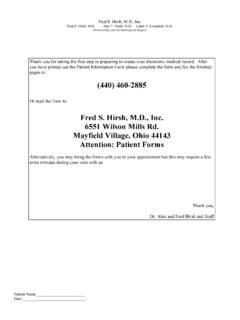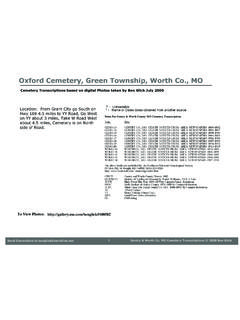Transcription of DIETARY LECTINS: BLOOD TYPES & FOOD ALLERGIES
1 1 DIETARY LECTINS: BLOOD TYPES & FOOD ALLERGIESL aura Power, Research Corporation6521 Arlington Blvd., Suite 104 Falls Church, Virginia 22042703-538-4161 Published in:Townsend Letter for DoctorsJune 19912 AbstractDietary lectins in excess can cause 3 majorphysiological effects: gastrointestinal damage, Type 2 IgG immune responses, and hemagglutination. Findingsinclude 119 lectins: 54 are panhemagglutinins; 65 areblood-type specific. Herein may lie a method forpredicting food sensitivities by ABO BLOOD lectins are protein antigens which bind to surface glycoproteins (orglycolipids) on erythrocytes or lymphocytes. (1) They function as both allergensand hemagglutinins. (2) They are found in plants and animals, and are present insmall amounts in 30% of American foods, more so in a whole-grain diet.
2 (2)Lectins have potent in vivo effects. When consumed in excess by sensitiveindividuals, they can cause 3 primary physiological reactions: Lectins can causesevere intestinal damage, disrupting digestion and causing nutrient deficiencies.(3) They can provoke IgG and IgM antibodies causing Gell-Coombs Type 2 foodallergies and other immune responses. (3,4) And they can bind to erythrocytes,simultaneously with immune factors, causing hemagglutination and anemia. (5)Of the 119 known DIETARY lectins, about half are panhemagglutinins, clumping allblood TYPES . The remainder are BLOOD -type specific. In general, lectins alter hostresistance to infection, cause failure to thrive, and can even lead to death inexperimental animals. (2)HistoryLectins have been known for a century. They were discovered in castorbeans by Stillmark in 1888 (6), and in non-toxic plants (beans and lentils) in1907.
3 (7) By 1945 Boyd found that some lectins were BLOOD -type specific. Hereported that lima beans will only agglutinate BLOOD type A. (6) Since that timelectins have been found in both plants and animals -- particularly in edible cereals,beans, seeds, nuts, fish and shellfish. (7) And some foods are known to have 2 ormore lectins. Many species-specific lectins have also been identified. Todaylectins are commonly used in laboratories to type BLOOD , particularly type A1. (8)4 AbsorptionMany lectins are relatively resistant to both heating and digestion. Manyhave a high thermal stability (70 C > 30 min), and do not completely degradewith cooking. Some are also relatively resistant to stomach acid and proteolyticenzymes. (9) Thus, while some lectins are degraded and others pass through thegut, about 1% to 5% absorb into the BLOOD stream in animals, which is considereda significant amount, sufficient to cause an immune response.
4 (3) Furthermore,lectin absorption can be higher if eaten raw, or eaten by individuals deficient instomach acid, proteolytic enzymes, or secretory IgA antibodies which bind lectinsin the gut. (3)In Vivo TestingPusztai et al report that in vivo testing of lectins has been performed onanimals: rats, mice, pigs and steers. This included the feeding of high lectin diets,direct studies on 125I-lectin uptake from the gut, BLOOD assays for IgG and IgEantibodies, and dissection and examination of the intestines, liver, pancreas, spleenand thymus. Results showed severe intestinal lesions, and high titres of circulatinglectin-specific antibodies, with direct relationship to the severity of the toxicsymptoms. The main target tissues were the thymus and small intestine. However,lectins had relatively minor effects on the liver, pancreas, and spleen.
5 (3)Human ReactionsIn humans lectins have been reported to cause damage, including mass foodpoisoning from raw or under-cooked kidney beans (10,11), and hemolytic anemiaand jaundice from Mexican fava beans (in Glucose-6-Phosphate dehydrogenasedeficient individuals). (12)51. Intestinal DamageDigestive DistressLectins can cause acute gastrointestinal symptoms, including nausea andvomiting. They bind to the luminal surface of absorptive enterocytes in the smallintestine. This severely damages the microvilli of the enterocytes, disruptingdigestion and absorption. Lectins can increase intestinal weight and cell number60-80%, creating gas, fluid and mucus. (3) Lectins can even promote the growthof harmful bacteria in the gut. (13)Protein MalabsorptionLectins can disrupt protein absorption.
6 In the gut lectins bind toenterocytes, causing lesions and inflammation, blocking the production ofenterokinase, a protein enzyme. This interferes with protein breakdown and withnitrogen absorption in the gut. And it explains why animals on high lectin dietsshow increased fecal and urinary nitrogen loss, resulting in a negative nitrogenbalance, and retardation of long-term growth. (3)Carbohydrate MalabsorptionLectins can also disrupt carbohydrate absorption and metabolism. Lectinscan reduce intestinal glucose uptake by 50%. (10) Concanavalin A in Jack beans,Wheat Germ Agglutinin, and other lectins can even bind to insulin receptors oncells, disrupting glucose metabolism. (11) Finally, because of the high lectincontent in grains, it is speculated that lectins cause inflammatory bowel (2) andceliac disease in humans.
7 (10) In fact, Freed has found that the gliadin toxin is anisolectin of Wheat Germ Agglutinin. (10)62. Immune ResponsesLectins can evoke a variety of immune responses, but they primarily causeType 2 ALLERGIES . (3) To review the 4 allergy TYPES see Table 1 and Figure 2 AllergiesLectins primarily evoke IgG and IgM antibodies, causing Type 2 's results showed high titres of circulating lectin-specific IgG antibodies(but no reaction to other foods), and a direct relationship between the severity oftoxic symptoms and the antibody titre. (3) Lectins can cause: fatigue, headache,achiness, diarrhea, nausea, vomiting, irritability, and hemolytic anemia. (12) Type 1 + 3 AllergiesLectins can also cause Type 1 ALLERGIES involving IgE antibodies. (3) Andin large quantities they can even induce histamine release from BLOOD basophilsand from mast cells without IgE intervention.
8 (10) Lectins can also combine withcomplement and neutrophils to form Type 3 immune complexes. This canprecipitate in the BLOOD vessels, causing vascular lesions, resulting in thrombosisand hemorrhage.(11) Or it can circulate through the BLOOD to the kidneys, whereit lodges in the glomerular tufts causing inflammation or nephritis.(12)Other Immune ReactionsLectins such as Concanavalin A in jack beans can bind to T-cells and otherlymphocytes triggering cell mitosis.(1) Tomato lectin agglutinates not onlyerythrocytes, but human lymphocytes and granulocytes.(9) Lima beans and otherlectins bind to adenine and some cytokinins.(1) Lectins can alter host resistance toinfection and to tumor challenge by exhausting the immune system.(2)7 Table 1 The 4 Gell-Coombs Allergy TYPES (4,5,12) Type 1: Reagin (IgE)Caused when allergens react with IgE antibodies on mast cells inmucous membranes to release histamine.
9 Immediate responses occurwithin 1-60 minutes. Late-phase responses occur within 12-72 hours, cantake 3-4 weeks to diminish. Accounts for 10-20% of food Symptoms: Hay fever, rhinitis, asthma, hives, eczema,and in children flushed red cheeks and hyperlinetic Symptoms: Migraines, neurological disorders, arthritis,bladder inflammation, gallbladder disease, heart and vascular disease. Type 2: Lectin (or Cytotoxic)Caused when IgG or IgM antibodies bind to lectins on red or white BLOOD or K-Cells can attach, agglutinating the responses occur in 12-72 hours. Involved in 80% of food : Fatigue, insomnia, headache, achiness, diarrhea, nausea, vomiting. In severe cases hemolytic anemia or immune exhaustion. Type 3: Immune Complex (IgG)Caused when IgG antibodies form large antigen-antibody complexes.
10 Complement and neutrophils can attach. They can deposit in tissues. Delayed responses occur within 12-72 hours. Involved in 50% of food : Fatigue, headache, irritability, depression, fear, hyperactivity, confusion, learning disorders, arthritis, muscle pains, liver & kidney disease,heart and vascular disease, neurological disorders and schizophrenia. Type 4: T-LymphocyteCaused when macrophages interact with T-lymphocytes in tissue cells, bothrelease inflammatory cytokines. Delayed responses occur within 24 in 40-50% of food Contact Symptoms: Bowel lesions, ulcers, colitis, regionalileitis, arthritis, liver and kidney disease, and neurological Contact Symptoms: Poison ivy, or other Food LectinsIgGAntibodyRBCC omplementK-CellFigure 1: Gell-Coombs Type 2 Food Allergy Reaction:IgG antibodies bind to food lectins on a red BLOOD protein can attach via the alternate complementpathway, lysing the cell.






